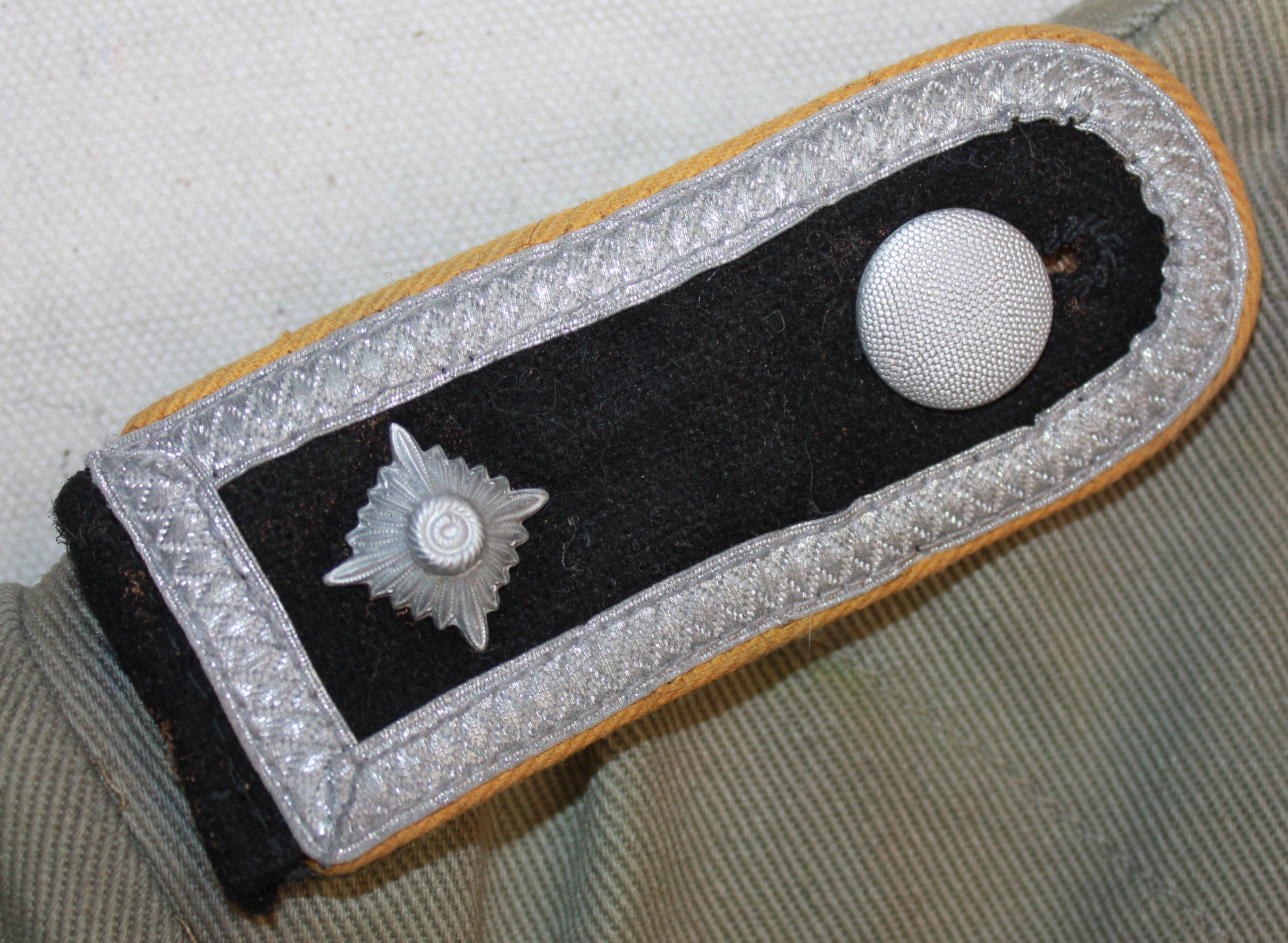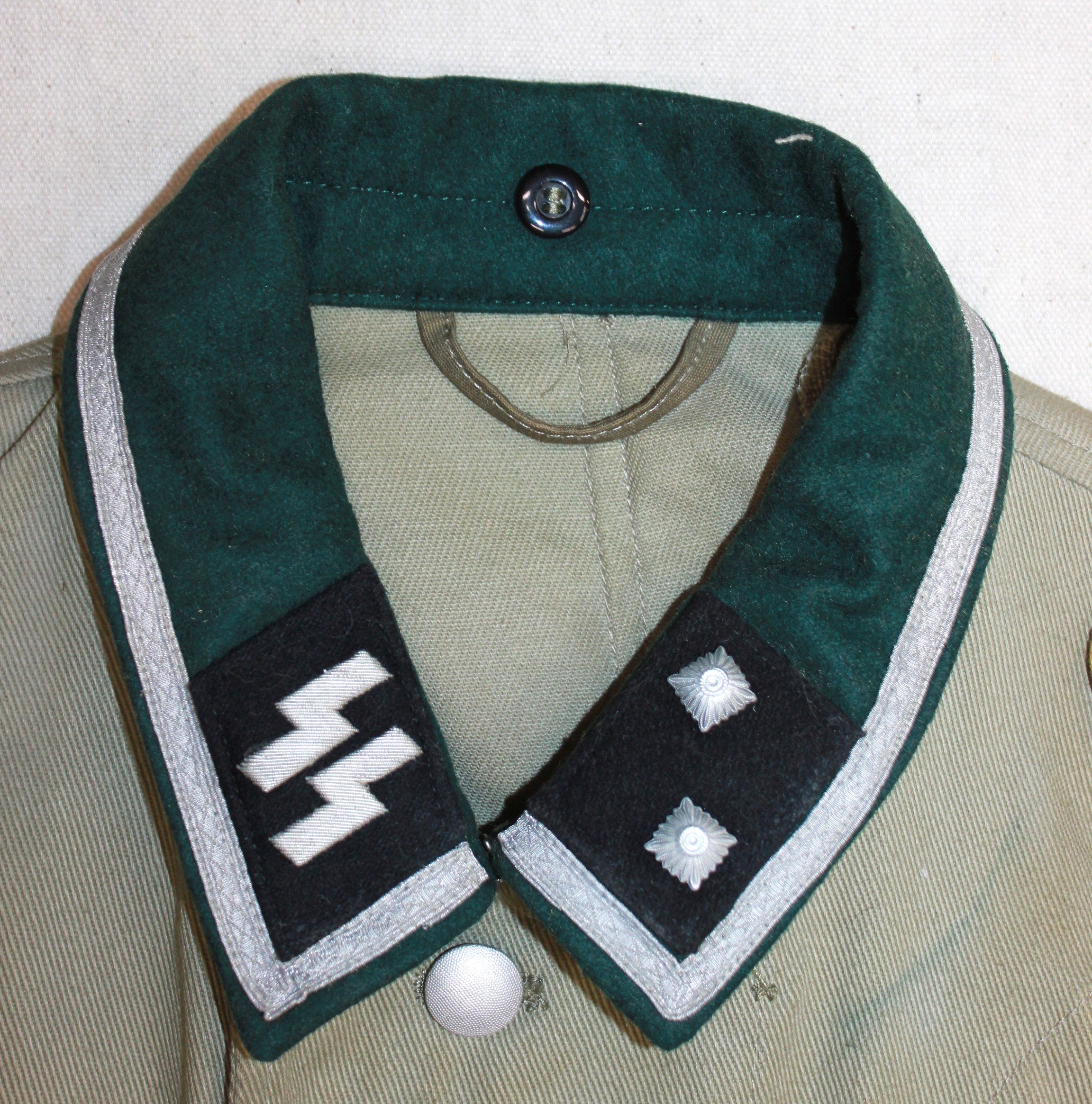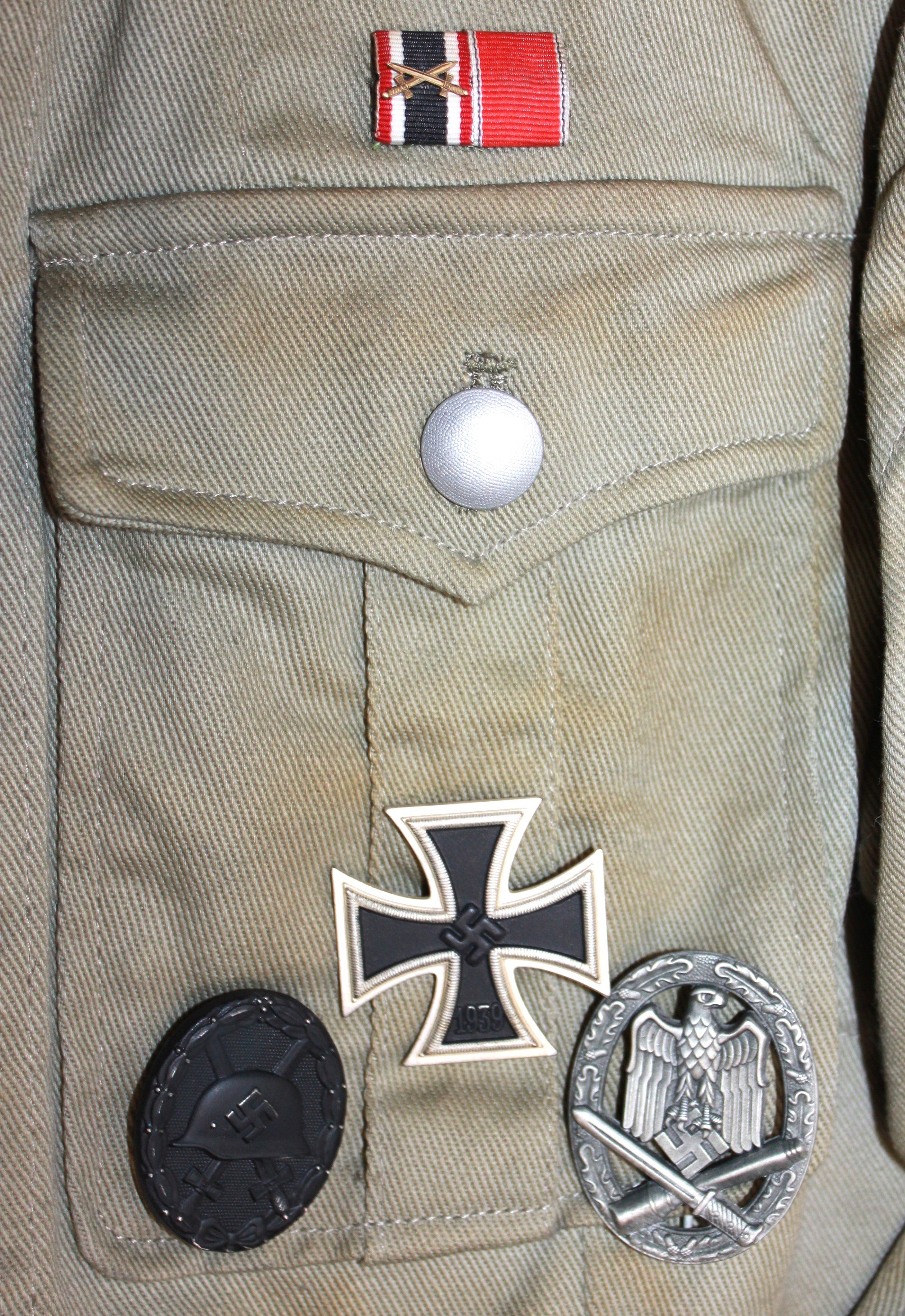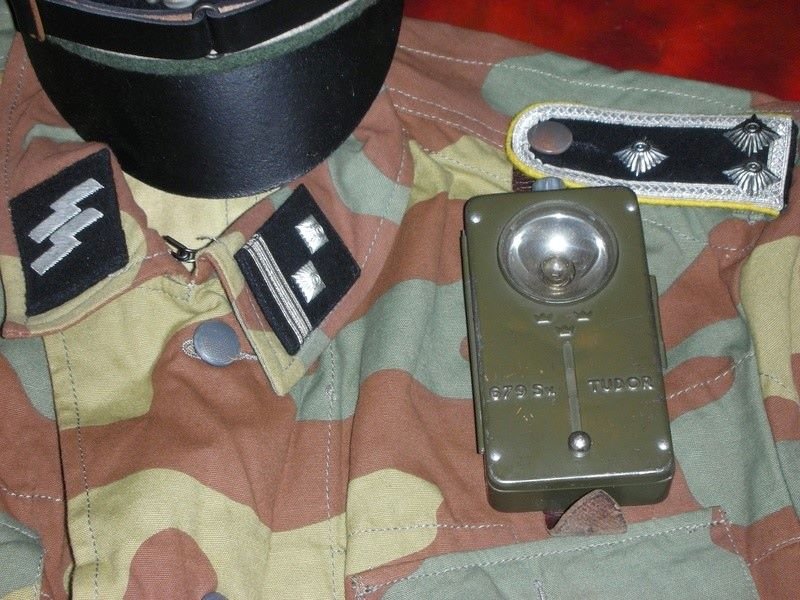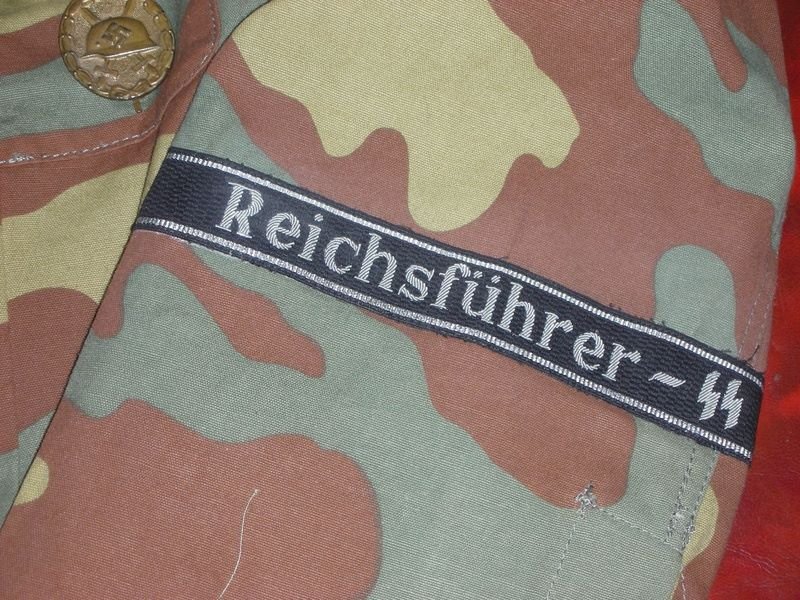Other Waffen-SS uniforms:
SS-Unterscharführer, SS-Unterführerschule Lauenburg:
Waffen-SS Unterführerschulen was built (see the initial sketch) and opened in 1940 in both Larenburg and Radolfzell. These schools are designed to facilitate the training of junior non-commissioned officers. However, they also provided initial German leadership training to all ranks of volunteer units shown by the class manifest of the Frw. Legion Niederlande.
The junior NCOs attending the schools wore special machine chains stitched Schulterklappen with either US L or US R cipher. A school Ärmelstrifen was also produced. An Ost Front 1941-42 veteran, the SS-Unterscharführer wears a Heeres Dienstanzug Model 1936 uniform and an NCO version of the Schirmmützen while he attends class. These hats were worn in leadership roles, training, schooling, and guard duty, and often used even in the field if they needed it to be known they were in charge of any particular element, platoon, squad, or special section. etc. Again, we have a complete uniform, made around a set of old shoulder-boards. The Sholderboards are one of the rarest I have in my collection, and they had sat around for a long time before they found a home.
SS-Oberscharführer, SS-Aufklärungs abteilung “Ost-Bluse”:
Kraftfahrbewährungsabzeichen u. Ärmelschild Demjansk Pattern on the Heeresdienstanzug Model 1936. The ‘Ost Bluse’ was a warm-weather uniform made from captured Soviet cotton cloth. Because of the custom tailoring, the individual chose the insignia that went on the uniform from what was available or from an older uniform. In the case of this SS-Oberscharführer, he has utilized officer grade insignia on the Bluse and the Eineheitsfeldmütz. The award of the Ärmelschild Demjansk is puzzling, as the Waffen SS combat element associated with this battle is the SS-Panzergrenadier Division “Totenkopf”. The runic collar Litzen was not the norm for this unit’s insignia. So the unit he’s in has changed a couple of times, and it's unclear exactly.
A leader in the motorcycle-equipped Aüfklarungsabteilung, he has earned numerous decorations for combat and the rare Kraftfahrbewährungsabzeichen or Driver’s Proficiency Badge in Gold. Ärmelschild Demjansk was awarded to Wehrmacht personnel who fought in the Demjansk pocket on the Ost Front in the early months of 1942. German troops encircled and cut off by the Red Army around Demjansk successfully defended the city and area with the aid of a Luftwaffe supply airbridge.
The shield was instituted on 25. April 1943 by Adolf Hitler and was not bestowed after 1. July 1944. Around 100,000 personnel qualified by being in the pocket between 8. February 21. April 1942. The requirement for ground units was honorable service in the besieged area for 60 days, or a shorter period if wounded. Luftwaffe personnel required 50 combat or resupply missions over the besieged area.
Kraftfahrbewährungsabzeichen or Driver Proficiency Badge was established on 23. October 1942 to reward drivers of military transport vehicles, including trucks, cars, and motorcycles, who served for specified periods in a war zone after 1. Dezember 1940. Both service personnel and civilian drivers under Wehrmacht command could qualify, as could foreign volunteers, but not members of forces allied to Germany. The requirement for the award was to have served since 1 Dezember 1940 on the front line or in rear areas on the Balkan, North African, and Eastern Fronts, with other areas added as the war progressed.
The qualifying period depended on the type of vehicle driven. For the bronze badge, this was: “motorbike reconnaissance and dispatch riders”: 90 days; supply vehicles supporting the front line: 120 days; other forms of military transport: 135 days. The silver badge was awarded when these requirements were met for a second time, and the gold for a third time. The badge could be awarded for shorter periods where drivers faced particularly arduous conditions or for special driving achievement. Awards were authorized by battalion commanders and above or, for civilians, by the Ministry of the Interior. The award could be forfeited, for example, if the recipient drove dangerously or failed to maintain their vehicle. It could not be awarded posthumously.
SS-Untersturmfuhrer, 10. SS Panzer Division, "Frundsberg”:
Newly commissioned after a grueling Officer School at Bad Tolz, this leader is no stranger to danger. His decorations show he has served from the early days of the war, being awarded the Ost Front medal and the Infantry Assault Badge. Moving as a cadre from one of the pre-war SS divisions, he trained young soldiers to be Panzergrenadiers, as shown by the Panzer Badge in Bronze. His leadership and bravery are noted by his Iron Cross 1st and 2nd Class and Close Combat Bar in Silver. Another very late war, very decorated soldier.
Like many officer candidates before him, he moved to where he was needed and showed promise; for this soldier, it was the Panzer School. Now, on the front, he leads tanks in battle in the last days of the war. He wears the late-pattern 44 Dot tanker jacket with a standard officer crusher cap. He has matching issue camouflage trousers.
Camouflage is very important to tankers whose tanks have been destroyed or disabled as they fight their way back to get another panzer or fight as infantry. The uniform has been depicted with several different caps, one was a cloth-covered bill, a crusher cap, and the other a pink-piped Crushed-Schurmutz, but no further pictures have been taken of them, the caps moved around with other uniforms, as they went in my early collection, picture shoots, and neither would be my picks today. The next cap may be different, like an M43 Officers style.
Unterscharfuhrer, SS-Frundsburg, ‘Waspe’ Self-Propelled Gun Commander:
This SS-Frundsburg Unterscharführer wears a uniform cut in an M44 style, and the popular “Spring-Oak” pattern on a light material, and while the trousers are of an Italian pattern, not a match, but they are in a summer weight too. In command of a self-propelled Gun, he could be identified by the binoculars he would commonly have hanging from his neck. I have him with a red-piped crusher or any cap, but by then, there were many options, so I threw in the blurred-edge-pattern summer cap. He would have likely had a black dyed, enlistedman’s belt, and possibly a holstered weapon in it, and black short boots. The shirt underneath may be gray, but by 1943, the shirt had become field gray.
*SS-NCO, SS-Regiment, Hermann Von Salza:
*Added some more (Old Pictures) here, but need to dig out the story and get that in here, I have a bad habit of over-decorating these uniforms, granted, but they often also show odd or different variations of common badges, as in this case.
SS-Rottenführer, SS-Panzergrenadier Regiment 35 “Reichsführer-SS”:
Waffen-SS units serving in tropical climates such as the Balkans, southern Russia, Italy, Greece, and the Mediterranean islands required a tropical uniform to deal with the sweltering summer heat. Period and collection photos show that the SS made use of both the Heer and Luftwaffe tropical uniforms as the SS-Bekleidungswerk slowly developed an SS issue uniform for the purpose. Following the invasion of Greece in 1941, members of the 1. SS-Panzer-Division “Leibstandarte SS Adolf Hitler” resorted to wearing sports kits when not in combat, and the ‘shirtsleeve’ order was used while combat duties permitted. The first SS Tropenbluse debuted as the SS model in 1942. The design is very similar in appearance to the Italian tropical ‘Sahariana’ made from lightweight tan cotton and featuring four pleated front pockets. The interior was lined with a minimal layer of tan cotton.
The early issue came with removable tan or olive-colored pebbled glass. Unlike other standard Bluse, the SS tropical M42 features two fabric tunnels, rather than loops, to fit removable Schulterklappen to the uniform. The waistline features inverted metal hooks to hold the cartridge belt in place, as well as a drawstring to adjust the fit. To increase ventilation, the swallow-cut front and back panels, as well as ventilation eyelets under the armpit, were part of the design. In 1943, the SS introduced a second pattern tropical uniform, the SS-Model 1943, the major adaptation being the removal of the pocket pleats. Few members of the Waffen-SS wore the SS Tropenbluse, and it was primarily issued to the 1. SS-Panzer-Division “Leibstandarte SS Adolf Hitler”, 4. SS-Panzergrenadier Division ”SS-Polizei”, and the 16. SS-Panzergrenadier- Division “Reichsführer-SS”, who served in the Italian and Greek theaters from 1943.
A large number of the Tropenbluse were found at the Dachau clothing depot following the German capitulation. The tropical uniform was not to use the collar tab litzen (See period photos), but the SS was used to that form of rank identification, and some added it. The addition of Litzen became standard. In addition, a standard continental rank chevron has been added below the RZM pattern tropical tan SS sleeve eagle. The uniform is completed with the SS-Tropenfeldmütz mit BEVO abzeichen along with matching Tropenhosen. Period photos show both Marchstiefel and low boots being worn. The SS-Rottenführer had been in combat, as shown by the Infanterie Sturmabzeichen and Verwundetenabzeichen Schwarz displayed on the newly issued Bluse.
SS-SturmscharfÜhrer, 16. SS-Signal Battalion, SS-Panzer Grenadier Division “REICHSFÜHRER-SS'“
Both the Waffen SS and the Heer stations in Italy made use of stocks of Italian camouflage or any available fabric to produce summer-weight combat uniforms. Some had matching trousers, and M43-style caps were also produced locally, although the same patterns were in different tinted colors.
Reichsführer-SS was raised in Slovenia in 1943 by German and Volksdeutsche troops and sent to the Mediterranean Front by January 1943. In February 1944, it was engaged in the Anzio battle. By May, the division had returned to Germany for reorganization and then shipped back to Italy to fight in the North till December, when it transferred to Hungary to fight the Soviets, ending in Vienna in April 1945.
This Sturmscharführer may well be the senior NCO in the signal section, probably commanding the headquarters section during some actions. He has had officer-quality insignia sewn onto his uniform and wears a custom-produced Schirmrnutz that has been slightly crushed. His awards show a soldier of combat experience with the Ost Front Medal, showing service in one of the early SS divisions that invaded Russia. Severely wounded, he has returned to the front and wears the Gold Wound Badge, but is still out in the field with a debilitating wound. His combat leadership is recognised by both 1st and 2nd class Iron Crosses.
Note: The last picture is of the same period and is said to be of the same outfit, but the troops are wearing winter thermal uniforms, so the camouflaged jacket could have been worn over the wool uniform in the photoshoot.
“Story Added” SS-Obersturmbannfuhrer, 16SS Panzergrenadier Division, “REICHSFÜHRER-SS'“:
Forming up in October 1943 in Slavonia with the Sturm-Brigade “Reichsführer-SS”, recently returned from Corsica, with Volksgrenadier recruits. The New Division trained until January 1943, when it returned to combat on the Mediterranean Front. In February 1944, elements were committed to the fighting at the Anzio area. Other parts of the Division were moved over to engage in the occupation of Hungary in March. In May, the Division as a whole (or what was left of it) transferred to Germany, reunited as part of the OKW Reserve. In June 1944, they went back to Italy to shore up against the American push on the Gustuv Line. The fighting was hard and brutal, and costly all around, and they continued falling back, to stop and defend again at the Gothic Line around Bologna, then they were moved to Hungary, with the horrendous fighting along the Southern Section of the Eastern Front, their final battle was in Vienna, in April 1945.
With the rank of SS-Obersturmbannführer or the equivalent of a Lieutenant Colonel, you can get things done, and this is one of those cases, able to receive a 2-pocket, SS camouflage-over jacket in the green-brown SS-Blotch Pattern #6, some may have been factory produced, or it may be a custom item. The breeches are nice too, Stone Gray Gabardine material. The uniform originally had the wool, Feldnutz fur Offizier, with an interesting addition of metal insignia rather than cloth. With this uniform, I’ve used an optional, rare, soft-edge camouflaged cap. On the upgraded pictures, I have added the Officer’s crushed “Schirmmutz”. When the uniform first came up, I had a picture of a similar uniform and rank, but realized it was Italian Camouflage, but a good reference of what was being made. I can’t find that picture now, but it went great with this uniform. He would have had a gray shirt underneath, with a Black 2-prong officer’s belt and sidearm. Gray gaberdine riding breeches and black riding boots complete this example.
*SS-Oberscharführer, SS-Panzergrenadier Regiment 38, 17. SS-Panzergrenadier Division “Gotz von Berlichingen”:
17. SS- Panzergrenadier Division was raised near Poitiers, France, in October 1943, formed from scratch with the majority of its original senior cadre coming from SS-Ersatz or replacement units, with the Soldat being mainly Romanian Volksdeutsch conscripts. The division was named in honor of Götz von Berlichingen, a German knight of historical legend, who adopted his iron prosthetic clenched fist as the division’s emblem.
SS-Obersturmführer Otto Ringe oversaw the division's formation, with SS-Brigadeführer Werner Ostendorf taking command in January 1944. The division was placed under the LXXX Armeekorps, a part of the Generalfeldmarschall Gerd von Rundstedt’s Heersgruppe D.
The division fought only against American forces in several engagements from the D-Day invasion until the end of the war. SS-Oberscharführer led a platoon or even a larger group of soldiers in the last months of the war.
SS-Oberscharführer led a platoon or even a larger group of soldiers in the last months of the war. A seasoned combat leader, a veteran of the Ost front, he has been part of the division cadre since the beginning. Arriving from a replacement or other training command, he has led his Volksdeutsche conscripts against a much superior American force. His SS-Dienstanzug M43 has a unique mix of BEVO or machine-woven and RZM or machine-embroidered insignia, including the Divisional Ärmelstreifen.
He wears a late-war pattern SS-manufactured Einheitsfeldmütze with a final pattern trapezoid BEVO insignia. * I’ve added a helmet here, it needed a home, and the uniform a helmet, I think it fits ok, although somewhat rare to see them painted up, for any of the forces, and with the cork added even rarer, but its been laying around here for ages, and is an interesting subject, as is the uniform, so it will be here for now.
Panzer, Lieutenant, 17th Panzer-Grenadier Division, SS-Gotz von Berlichingen:
Götz von Berlichingen was a German knight, soldier of fortune, and sometimes robber baron. He was born around 1480 to a noble family at the Schloss Jagsthausen in Württemberg. Berlichingen was made famous by writer and poet Johann Wolfgang von Goethe 1749-1832, who wrote a play based on his life. He first entered the service in 1498. He fought in the armies of Holy Roman Emperor Maximilian I. In 1500, Berlichingen formed a company of mercenaries, hiring his services for various dukes, margraves, and barons for a fee. In 1508, he and his company fought for Albert IV, Duke of Bavaria.
During the siege of the city of Lanshut, he lost his right arm to enemy cannon fire. He then had a prosthetic iron replacement made, which is still on display at the Schloss Jagsthausen. Berlichingen continued as a mercenary, conducting raids on rich towns or merchant caravans with the occasional kidnapping for ransom of minor nobles. Placed under an imperial ban, he was only released by paying 14,000 guilders to Emperor Maximilian. Berlichingen and his company mounted a raid into Hesse, capturing Philip IV, Count of Waldeck, and were again placed under the ban. During this time, the bishop of Bamberg sent an emissary to Berlichingen’s castle and demanded his surrender. His reply went down in history and became famous. Leaning over his castle ramparts, the knight shouted: ‘Er kann mich im Arsche lecken!’ or ‘He can lick (or kiss) my ass!’ A common German insult is to say: ’Götz von Berlichingen’ or merely ‘Götz’. Götz continued as a knight warrior and leader. He served, without pay, fighting against the Ottoman Empire of Suleiman the Magnificent in Hungary.
This was service to Charles V, Holy Roman Emperor, and in 1544, he was at the forefront of the battle in the imperial invasion of France under Francis of France. He then finally returned to the Hornburg and lived out his days in relative peace. He died on 23 July 1562 in the castle at Horneck; he was 82.
The uniform depicts a Panzer Officer of the Division. It carries the early, enlisted pink piping on it and has a 1st class Crusher Cap. What sort of tanks the unit had received and went to battle with is questionable. They were thrown into battle in the Allied Normandy Invasion Operation and had been assigned German Paratroopers to assist them in throwing out the invaders. They ran into American Paratroopers, and the battle got ugly, fighting back across France. There were several atrocities reported by the German SS operating there, and both sides suffered heavy casualties.
Then, there was a brief Refit before Operation Nordwind. Still, it’s not clear if there were any tanks; there were several assault gun conversions acquired, and some StuGs delivered to them, with the high point being about 34 vehicles. During the main battle, they received a company of Panther Tanks, and a group of Jagdpanthers as well, but it did not change the outcome of the event, it failed with terrible weather conditions and up against 44th and 100 Infantry Divisions, and the 7th US Army, they were continuously pushed back into Germany, in brutal fighting, they had remained in combat with the US XV Corps until January 30, 1945. So we see some pictures off the internet, of what I think were people in the unit, and a set of special wraps from my collection that represent the unit, that could have been in any of the fighting vehicles.
1st Leutnant, Stug Regiment, 17th Panzer~Grenaider Division, SS-Gotz von Berlichingen:
The second uniform of this set or special wrap uniform shows the popular oak pattern, the Green and brown blotched “Spring” pattern camouflage material. He is a Commander of a Self-Propelled Gun battery rather than a Panzer (Turreted-Tank). Hastily equipped, with what was available, his mismatched group of vehicles was anything but standard, they got what they could get, and their tank regiment was more a myth than reality, likely made up of captured, obsolete, and concerted vehicles, it is reported that they received 42 Sturmgeschutz IV Assault Guns (these were a very formidable weapon) and some other french hulled. SP-Gun conversions, with the crews receiving only a few months of training, were also below strength in officers and NCOs.
Existing for less than a year the unprepared, poorly equipped, with little fuel, ammunition, or supplies of any sort, they were not a Division, but a paper division for Hitler, they did fight, and hard, with what they had, surly with mixed units and mismatch of SS and Heer even Luftwaffe units form all sorts and retreating, getting all chopped up as they went, they were being overwhelmed by the Allied Forces operating in Normandy were in a fight for their lives, and knew they could not hold the ground, and after days of bombings not only was equipment devastated so were the soldiers, and the people, the people, their homes and their towns were devastated, anywhere one went. The fields and the beaches- everything was affected by the Allied Invasion of France, and the German (and Axis Forces) both did their share of just blowing up everything as they went.
An SS-Oddity, SS-Mann, Splittertarnmuster Sonderbekleidung der Panzertruppen:
The black wool Sonderbekleidung der Panzertruppen was hot when worn in the warmer southern combat theaters, but it also stood out when the Panzer crewman was outside the tank, making them an easily spotted target. In 1942, the Heer began issuing the Feldbluse made of reed-green HBT material. By 1943, a version based on the Panzer uniform was introduced. Envious of the Infanterie Soldaten's new uniform and not wanting to wait, Heer Panzer crews often created their warm-weather uniform from the Zeltbahn, which helped eliminate the visibility issue when not onboard the panzer, and for reconnoitering.
Waffen-SS Panzer Divisions were established in 194,3, and tank crews would wear a standard camouflage smock over their black wool. Wishing for a cooler option, photos show SS-men adopted both the Heer issue green HBT as well as the field-made Splittertarnmuster version of the Panzer uniform. SS units never had an official summer uniform until the issue of the 1944 camouflage over uniform cut in the dot pattern into both the Feldbluse and Panzer styles.


















